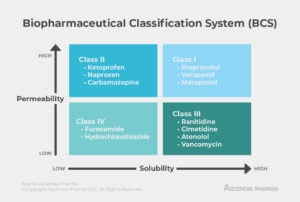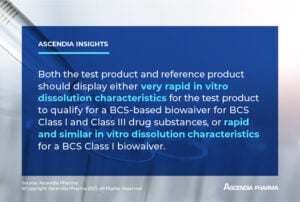5 Novel Techniques for Solubility Enhancement
For a drug to be properly absorbed by the body, it needs to be in a solution state at the point of absorption. The solubility of a drug is crucial to ensure the right concentration of a drug gets into the bloodstream so the bioavailability of the drug causes the desired pharmacological response. Solubility is a key factor in determining how effective a new drug solution will be. Solubility enhancement techniques can help.
Thanks to advances in combinatorial chemistry and high-throughput technologies, the number of new drug candidates has soared, yet about 40% of drugs with market approval and nearly 90% of molecules in the discovery pipeline are poorly water-soluble. ¹ When poorly soluble drug products make it to market, they may gain marketing exclusivity and patent protections. The practice of reformulating them to improve efficacy, patient compliance and safety has now been widely adopted by many pharmaceutical companies thanks to insoluble drug delivery technologies.
That’s where various insoluble drug delivery techniques come in to solve the formulation challenges with poorly water-soluble drugs.

Solubility and the Biopharmaceutical Classification System
Oral delivery is the most common pharmaceutical administration route due to its ease for patients to take, high compliance rates, ability to develop various dosage form options and lower (on average) overall cost of drug formulation.
That’s where solubility in aqueous systems, dissolution rate and permeability come into play, as they determine the bioavailability of pharmaceuticals taken orally. A lower solubility means more of the drug is needed to cause the desired pharmacological response, which can mean an increase in negative side effects.
The Biopharmaceutical Classification System (BCS) was originally proposed in 1995 by Amidon et al. It serves as a scientific framework used to review and classify drugs based on aqueous solubility, intestinal permeability and dissolution rate. BCS is a commonly used tool in drug development to determine the correlation of solubility and permeability with the bioavailability of drugs.
BCS Classes
The BCS differentiates drugs based on their solubility and permeability, and is divided into four classes:

• Class I – Drugs have both high permeability and high solubility
○ Examples: Propranolol, Verapamil and Metoprolol
○ These drug compounds have an absorption rate that is typically higher than excretion.
• Class II – Drugs have high permeability, but low solubility
○ Examples: Ketoprofen, Naproxen, Carbamazepine
○ The bioavailability of these drug compounds is limited by the rate at which they dissolve. This points to a correlation between the in vivo bioavailability and the in vitro solvation.
• Class III – Drugs have low permeability paired with high solubility
○ Example: Ranitidine, Cimetidine, Atenolol, Vancomycin
○ The drug dissolves quickly, but the absorption is limited by the low permeation rate. If the formulation does not change the permeability or gastro-intestinal duration time, then class I criteria can be applied.
• Class IV – Drugs have both low permeability and low solubility
○ Example: Furosemide, Hydrochlorothiazide
○ These drug compounds are typically not well absorbed, leading to low bioavailability and high variability in pharmacological response.
A drug is considered highly soluble when the highest dose strength is soluble in 250 ml or less of aqueous media within the pH range of 1 to 7.5. Permeability is indirectly based on the extent of absorption of a drug compound in humans through direct measurement of rates of mass transfer across the intestinal membrane. Drug absorption can also be predicted using in-vitro culture methods. Dissolution is determined by the rate at which a drug substance dissolves. For example, if 85% of a drug substance dissolves within 15 minutes using USP Dissolution Apparatus 1 at 100 RPM in 900 ml or less, it is considered rapidly dissolving.

BCS-Based Biowaiver Eligibility
Biowaivers mean that certain aspects of a drug component, such as solubility and permeability, are not considered (or waived) for product approval.
To be eligible for a BCS-based biowaiver, a drug substance must meet the criteria regarding solubility and permeability (BCS Class I and Class III), be an immediate-release oral dosage with systemic action, and have the same dosage form and strength of the reference product. If the test and reference products contain different salts but both belong to BCS Class I, the test drug substance may be eligible for a biowaiver. If the test product contains a different ester, ether, isomer, mixture of isomers, complex or derivative of a drug substance other than that used in the reference product, it is not eligible for a biowaiver due to the potential differences in bioavailability.
BCS-based biowaivers only apply if drug administration includes water. To qualify for a biowaiver without water, a bioequivalence study should be conducted.
When the highest single therapeutic dose of the test product doesn’t meet the high solubility criteria, but the reference product does, a BCS-based biowaiver may apply if dose-proportional pharmacokinetics can be demonstrated. Buccal or sublingual absorption drug products are not eligible for a BCS-based biowaiver application. Composition (excipients) and in vitro dissolution performance criteria also need to be met for a BCS-based biowaiver, and the potential effects of excipients on in vivo absorption, such as solubility, transit time, gastrointestinal motility and intestinal permeability should be evaluated.
Both the test product and reference product should display either very rapid in vitro dissolution characteristics (≥85% for the mean percent dissolved in ≤ 15 minutes) for the test product to qualify for a BCS-based biowaiver for BCS Class I and Class III drug substances, or rapid (≥85% for the mean percent dissolved in ≤ 30 minutes) and similar in vitro dissolution characteristics for a BCS Class I biowaiver.
5 Novel Techniques for Solubility Enhancement
Solubility is the most important factor when it comes to formulating a drug compound, as it impacts drug effectiveness and bioavailability, as well as safety. Therefore, using a variety of techniques to improve solubility helps drug companies launch a previously unapproved drug compound, which leads to patients getting the help they need through a new drug compound.
Solubility enhancement opportunities using conventional approaches include surfactant; pH adjustment; manipulation of solid state; self-emulsifying drug delivery system; micro-emulsion; particle size reduction; supercritical fluid processes (SCF); complexation (kneading, lyophilization/freeze drying); supercritical anti-solvent technique; microwave irradiation method; hydrotrophy; solid dispersion; hot melt method (fusion method), solvent evaporation and hot melt extrusion; co-solvency; floating granules; nano-suspension; precipitation technique; nano-crystals or nano systems; nano crystallization; and milling, high-pressure homogenization and precipitation.
Novel solubility enhancements include:
1. Liquisolid Technique – Many drug candidates are lipophilic and with low water solubility, making dissolution and bioavailability a challenge. With the liquisolid technique, liquid medications are converted into dry, non-adherent, free flowing and compressible powder mixtures. This is done by blending the liquid drug components with appropriate excipients, often known as carriers or coating materials.
2. Spherical Agglomeration – The spherical crystallization (SC) technique using the spherical agglomeration (SA) method is an agglomeration process that transforms crystals into a compacted spherical form during the crystallization stage. This reduces tablet size by eliminating the use of large amounts of fillers and improves flowability and compression characteristics of active pharmaceutical components.
3. Melt Sono Crystallization – A particle engineering technique used to modify the physicochemical and biopharmaceutical properties of drug Rosiglitazone-(RS)-5-{4-(2[methyl (pyridine-2-yl)amino]ethoxy benzyl]thiozolidione-2-4-dione, Melt sono crystallization (MSC) works as an insulin sensitizer, by binding to the pPAR receptor in fat cells and making the cells more responsive to insulin.
4. The Prodrug Approach – Prodrugs are inactive, bio reversible by-products of active drug molecules that must be transformed in vivo to unlock the active parent drug, which leads to the desired pharmacological effect in the body. Prodrug development can be very challenging, but it represents a feasible way to improve the erratic properties of drugs in development or already on the market.
5. Nanotechnology Approaches – Solubility can be improved by formulating drug compounds into nanoparticles with high specific surface areas, which aids in solubility and increases dissolution rate. If a solid dosage form is desired, the nanoparticles are stabilized by adsorption onto polymer carriers – a process conducted by fluid bed coating. Alternatively, the nanoparticles can be prepared as a suspension and administered as a liquid – either orally or by injection.
Your CDMO for Nano
Ascendia Pharmaceuticals excels in the application of nanotechnology approaches to overcome solubility hurdles and develop novel pharmaceutical products. Nanotechnology in the pharmaceutical field encompasses many types of formulation approaches, from nanoparticles to self-emulsifying lipid systems and dispersed amorphous systems to nano-emulsions to improve hot melt extrusion. Ascendia’s suite of state-of-the-art technologies for formulating poorly water-soluble compounds provide sophisticated formulation options for our clients, and the unique dosage forms we create can be administered orally, topically or by injection.
Ascendia specializes in the invention and development of specialty pharmaceutical products and novel formulation technologies (including nano-formulations), providing pharmaceutical companies with rapid, comprehensive and cost-effective solutions to improve drug bioavailability and solubility. We’re ready to hit the ground running – so contact us today!
References
- Kalepu, S., & Nekkanti, V. (2015). Insoluble drug delivery strategies: review of recent advances and business prospects. Science Direct, 5(5), 442–453. https://www.sciencedirect.com/science/article/pii/S2211383515001069

